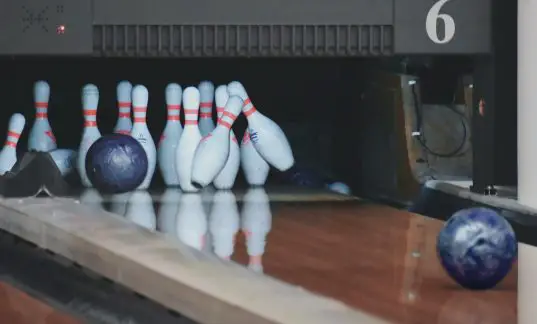If you’re living a life of gutter balls and foul line stumbles and you need some bowling tips, we’re here to help. Bowling is an unforgiving sport sometimes, especially for newbies. If your swing is out of whack or your footwork is wrong, a bowling alley might as well be your personal house of horrors.
Here’s a revolutionary thought — bowling should be fun! Whether you’re chucking house balls with friends over a few beers or you’re one of those beginners (or intermediate players) with professional aspirations, things should always be working towards bigger crashes and better scores.
If you’re struggling with your throwing technique or don’t know what a bowling throwing technique consists of, enlist the services of this article. We’ll help you find your approach, refine your approach, clean up your bowling stance, and turn your throwing arm into a weapon of mass pin destruction.
Let’s get going, shall we?
So, what is the trick to bowling?
The trick to bowling is balance. For right-handers and left-handers alike, bowling balls are only effective when paired with an effective, balanced approach at the lanes.
Your throwing hand, wrist, thumb, forefingers, and full arm need to work in concert with the rest of your body. The entire machine, from your bowling shoes to the position of your neck, needs to be in an optimal position to deliver the ball effectively to the pins.
The way you approach the foul line is everything. If you’re swinging your arm wildly with no rhyme or reason, it won’t matter where your feet are positioned. You need a complete shot approach — from gathering yourself at your starting spot to your follow-through when you release the ball.
Here’s how to make that happen.
What is the proper technique for a bowling shot?
Different bowlers have different shot routines. It can be a feeling-out process for beginners, though, so here’s a primer for how to develop an effective throwing technique.
- Tuck your throwing elbow at your side and steady the ball around waist height. Use your non-throwing hand for added support. Look for your target before you approach — usually the second target arrow to the right for right-handers. Count your steps if you need to. Be measured and careful in the way you approach.
- When you begin your swing, remember to swing your arm straight back. Do not wrap it around yourself when you throw. As you release the ball, your thumb should exit the ball first. The rest of your fingers should come out after.
- Keep your wrist firm as you release your shot. It takes practice to get your hands and wrist to cooperate. Your release point should be at the mid-point of your sliding left calf (or the right calf for left-handers). Your left foot should point towards your target, leading the way for your shot.
The more times you practice this in a game situation, the more control you’ll have at the bowling lanes. Take a high school student approach and study your game. Analyze your starting position. Try something different and see how it feels. And feel out the weight of the ball to make sure that your arm comfort and ball speed are where you want them to be.
Speaking of bowling balls…
How do you pick the right bowling ball?
Trust your arm and trust your fingers. For you to get strikes and find the pocket consistently, you need a ball that’s heavy enough to do damage. You also need a ball that’s comfortable to throw.
House balls are a good training mechanism. But, you should definitely work towards getting a custom ball drilled for your hand at your neighborhood pro shop. Good bowlers need good equipment. And the most important piece of equipment of all is your bowling ball.
The thing about shopping for bowling balls is that it’s an inexact science. Your finger holes should fit snugly around your fingers, but not so tight as to hurt them. The weight of the ball should be noticeably heavy, but not so much as to hurt your arm.
Test out some house balls and throw a few practice rounds towards the pins. Examine how your throws skid and slide in the lane oil at your local alley. If you’re veering left of veering right with your neighborhood oil pattern, let your local pro shop employee know that. They’ll help you find a ball that will work with you and not against you.
How much does a good bowling ball cost?
For a good strike ball, you’ll need a high-performance bowling ball that can adapt to different oil conditions. It’s the only way to score higher and consistently slot the ball in the pocket between the center pin and three-pin.
A good bowling ball costs around $120-250. This is the kind of ball that will make a headpin quake. New bowling balls are usually covered in reactive coverstocks which absorb oil, forgive mistakes, and help you find your groove towards bigger booms and better results.
How much do bowler accessories cost?
Bowling accessories to consider include bowling shoes, bowling bags, tape to protect your fingers, and so forth. First and foremost, you need a good pair of bowling shoes and a way to transport your new ball to the lanes.
When shopping for kicks, make sure you know how each brand’s shoe size runs. You don’t want shoes that are too tight or too loose on the lanes. A good budget pair of bowling shoes will set you back around $30 or $40. If you want to splurge, some comfy pairs of bowling kicks retail for around $80 or $90.
Bowling bags range in price from single-ball options around $20 to $200 or so for rolling, multi-ball behemoths. Regardless of which of these categories you choose, they are an essential buy to protect your ball. If your new ball gets nicked and scraped up, it’s going to be much less effective rolling down the lane.
Other accessories to consider include a rag for wiping sweat from your fingers and finger holes, bowling ball cleaner and polish, grit pads for maintaining the surface of your ball, and skin protection liquids that will keep your fingers from blistering.
We have plenty of articles on bowling accessories for you to consider. All things told you’re looking at a total investment of anywhere from $200 to $500 for your complete bowler setup.
How do you throw a hook shot?
Once you get your normal bowling shot down, it’s time to learn how to throw a hook. For you to up your scores and really do damage at the lanes, a hook shot is a vital part of your arsenal.
Here’s a step-by-step breakdown for beginners looking to throw an effective hook —
- You’re going to need to alter your approach at the lane just a bit to throw a hook. That includes how you grip the ball. A fingertip grip, with your middle and ring fingers inserted only to the first knuckle, is key. It’s a lot less comfortable than a normal throw to start. But, it promotes a natural hook.
- Your thumb needs to exit the ball in time with the final step of your left foot. That leaves your middle and index fingers to guide the hook. The longer your thumb stays in, the harder it will be for you to control your shot.
- As soon as your thumb releases, the weight of the ball will transfer to your index and ring finger. This should be at the lowest part of your swing. At this point, remove your other fingers and turn them counter-clockwise if you’re a righty. Turn them clockwise if you’re a lefty. When you do this, it should be in a single movement with a natural flicking motion up the side of the ball. This is called lift. It gives you control of your hook and more power to play with.
- To finish your shot, continue to swing your shot at the dots or arrows you’re using for your target. Swing it forward like you’re finishing up a handshake. This balances the revolution and rotation of the ball, allowing you to maximize your hook potential.
Getting your body, hands, and wrist to properly go with a hook shot takes time and practice. Keep working on it at your local alley. Find a bowling ball that feels comfortable to hook, be it a house ball or your own custom offering. In no time, you’ll be able to throw effective hooks for plenty of strikes.
And now that we’re on the topic of strikes…
How do you bowl a strike every time?
Sadly, it’s not possible. We can provide all the tips in the world. We can show you every professional method for attacking the pins. We can give you pointers one by one, refining your shot into a pin killer.
But, things happen. Your arm might tire out. Lane conditions change alley to alley. They even break down the longer you play.
Bowling is a game of adjustments. You have to pay attention to the little things. And you have to find a consistent throwing technique that works for you. Don’t worry about throwing strikes every time. It won’t happen.
Concentrate on making your best shot each time. The more you do that, the higher your scores will be.
So, how do I become a better bowler?
You become a better bowler by bowling! Find friends who like to bowl. Talk to other bowlers about your technique. Analyze your steps. Move your targets and see how things change.
The more you bowl and the more you think about bowling, the better things will go. We can’t promise that you’ll become a pro overnight. But, we can promise that hard work can turn open frames into spares and crushing strikes.
Hard work is hard, yeah. But, it’s effective.

